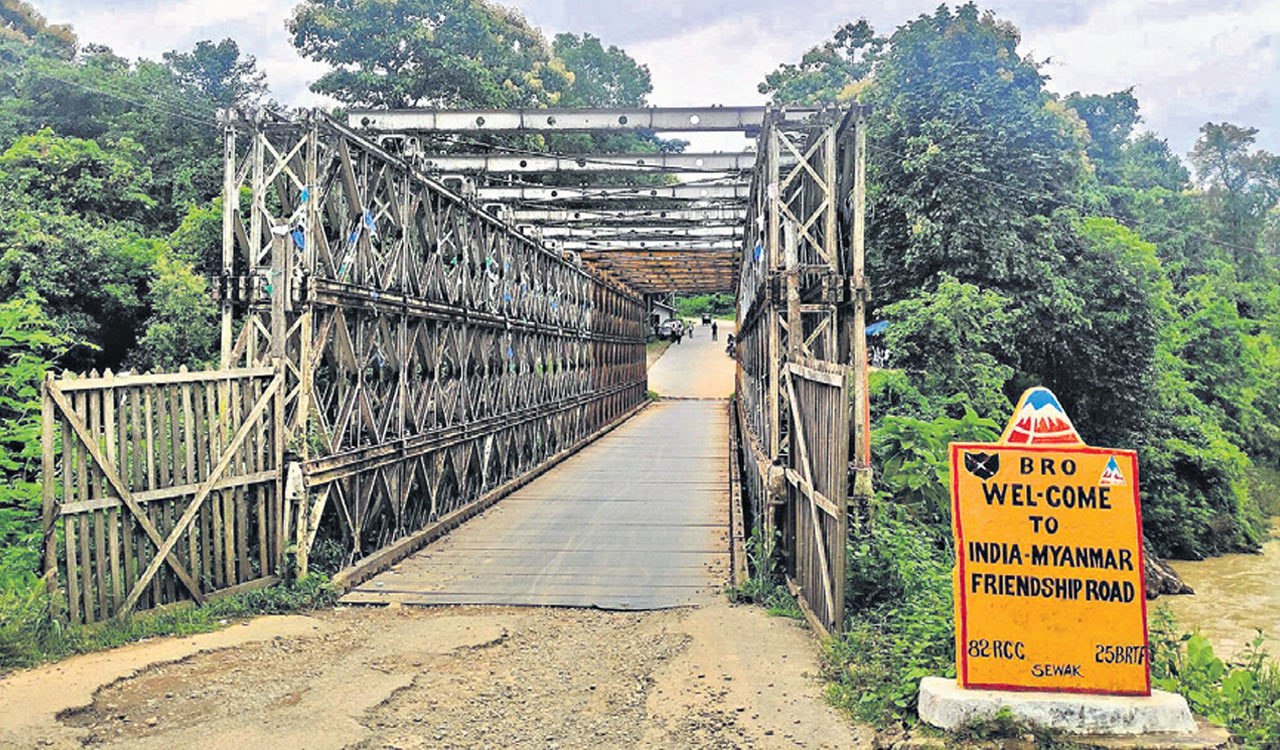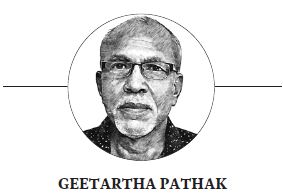Opinion: Good fences, unhappy neighbours?
Revoking Free Movement Regime with Myanmar is contrary to Act East and Neighborhood First policies

By Geetartha Pathak
Good fences make good neighbors,” said Robert Frost in Mending Wall, written in 1914. However, the Centre’s decision to erect border fencing along the Indo-Myanmar border has enraged the communities living on both sides of the border.
Free Movement Regime
Naga bodies, including insurgent outfit National Socialist Council of Nagaland-(Isak-Muivah) or the NSCN-(IM group ), and Mizo organisations have expressed grave concern at the decision of the Home Ministry to revoke the Free Movement Regime (FMR) between India and Myanmar and fence the 1,640 km boundary to facilitate better surveillance and pave a patrol track. While Chief Ministers of Arunachal Pradesh, Assam and Manipur have welcomed the decision, their Mizoram and Nagaland counterparts have opposed it.
Of these States, only Assam does not share its border with Myanmar. Manipur Chief Minister Biren Singh had appealed to the Centre in September 2023 to scrap the FMR agreement between the two countries that allows border residents to travel up to 16 km in each other’s territory without any visa. He argued that extremists had been exploiting the FMR to stoke ethnic violence in Manipur since May 3, 2023.
Home Minister Amit Shah said the Centre has approved Rs 31,000 crore for the construction of border fencing and roads, which will be completed by the Border Roads Organisation in phases over the next 10 years.
Shah too said fencing the Indo-Myanmar border was one of the strategies adopted by the Centre to control the violence in Manipur. He said fencing work had been completed in 30 km of the border, which he termed the root cause of the ethnic violence in Manipur. However, the argument placed by the Manipur Chief Minister and the Home Minister is not convincing as the FMR has been in operation since the pre-independence era, and there has been no such large-scale violence between different ethnic groups living in this region. The ongoing Meiteis-Kuki ethnic clashes started in May 2023 only. Therefore the CM’s as well as the Home Minister’s concerns seem to be unfounded.
Neighborhood First
Moreover, this decision is contrary to the central government’s stated principles ‘Neighborhood First’ policy and ‘Act East’ to foster closer trade, connectivity and people-to-people ties with Myanmar and Southeast Asia. It is also a reversal of our border movement regime with Myanmar which has been in existence since colonial times. It virtually seals the long border with our close neighbour. Of the 390 km border that Manipur shares with Myanmar, about 10 km is fenced.
Govt is spending billions to build fences along international borders but not investing enough in building people-to-people relations
The Kukis of Manipur were accused of helping their relatives from Myanmar to illegally migrate to India using the FMR. The Coordination Committee for Manipur’s Integrity (COCOMI), an organisation representing the Meiteis, alleged that the “Chin-Kuki narco-terrorists from Myanmar” were responsible for violence in Manipur. The “illegal migration” from Myanmar posed a threat to the culture and identity of the Meiteis, said one of the COCOMI leaders. Meiteis bodies went on to allege that Kukis were engaged in the illegal cultivation of poppies in the hills of Manipur at the behest of the “drug lords” in Myanmar and the drugs were sent to the rest of India as well as to other Southeast Asian nations. The allegations were strongly rejected by the community organisations of the Kukis.
Unification
The Kukis alleged that the Meiteis were trying to brand all Kukis as illegal migrants by demanding an Assam-like NRC in Manipur and thereby erasing their history in India. Mizos, Kukis and Hmars, who share ethnic bonds, have intensified the demand for “unification” of the people belonging to the Greater Zo communities living in India and Myanmar under one administration. The greater Zo community involves the Kukis, Mizos and Hmars, both in India and Myanmar, and the Chins of Myanmar and Bangladesh. Mizoram has also provided shelters to nearly 1,000 Chin refugees from Bangladesh. They fled the Chittagong Hill Tracts after the conflict between “rebels” and Bangladesh security forces.
The FMR evolved in recognition of the artificial and arbitrary nature of colonial boundaries and the close traditional, customary and kinship ties of cross-border tribal communities through the ages. Although it was Britain that drew the boundaries between India and then Burma after the Treaty of Yandabo in 1826 when the British took control of Assam and Manipur (along with other territories that it had wrested from the Burmese Konbaung dynasty after the 1st Burman War), yet they apprehend that any attempt to restrict cross-border relations and movement between divided ethnicities would invite trouble.
Mizoram Chief Minister Lalduhoma and his Nagaland counterpart Neiphiu Rio are also against erecting a barbed wire fence along the India-Myanmar border. Lalduhoma said the plan is “unacceptable”. He asserted that the people of the Zo community inhabiting both Mizoram and Myanmar have the right to live without any barrier between them. The Mizoram Assembly adopted a resolution opposing the Centre’s decision. The resolution urged the Union government to ensure that the Zo ethnic people, “who have been divided in different countries, are unified under one administrative unit”.
Former Nagaland chief minister SC Jamir too said the Centre’s decision is not only impossible but inhuman and a dangerous attempt to divide the people. He stated that when the international border between Myanmar and Nagaland on the Indian side was drawn, it was an imaginary line due to which many of the “real” Naga villages fell under Myanmar and some fell within Nagaland.
While visiting Longwa village in Mon district of Nagaland a few years ago, this writer saw that the ‘line’ goes through the middle of a villager’s house. The interesting part is that the Longwa village which is spread over both sides of the boundaries is governed by one village headman, who resides on the Indian side of the village.
The Centre as well as the State should look at the problem practically and whatever decision the government takes should be in consultation with all the stakeholders and with wider consensus. The imposition of arbitrary decisions will only deepen the crisis.
“Good fences make good neighbors” is a quote often misused. This line is frequently used to justify building a fence and keeping neighbours at arm’s length. But that was not what the poet meant. Frost’s poem is a metaphor for the walls we build that keep people out and apart. The real problem is with us and our failure to be good neighbours. Instead of developing relationships, we build fences so we never have to see our neighbours.
Our government is spending billions of rupees to build fences along the international borders between India and Pakistan, India and Bangladesh, China and Nepal, Bhutan etc but not spending enough energy and resources to build people-to-people relations and trust among the people across the border.

(The author is a senior journalist from Assam)
Related News
-
Former Home Secretary Ajay Kumar Bhalla appointed Manipur Governor, Kerala Governor shifted to Bihar
-
Ganges river dolphin tagged and released in Assam
-
Two Assamese held in Erode, 35 lakh worth heroin seized in a major drug bust
-
49th Sub-Junior National Basketball Championship: Telangana start strong, beat Assam 65-10
-
Cartoon Today on December 25, 2024
14 mins ago -
Sandhya Theatre stampede case: Allu Arjun questioned for 3 hours by Chikkadpallly police
55 mins ago -
Telangana: TRSMA pitches for 15% school fee hike and Right to Fee Collection Act
1 hour ago -
Hyderabad: Organs of 74-year-old man donated as part of Jeevandan
1 hour ago -
Opinion: The China factor in India-Nepal relations
2 hours ago -
Editorial: Modi’s Kuwait outreach
2 hours ago -
Telangana HC suspends orders against KCR and Harish Rao
2 hours ago -
Kohli and Smith will be dangerous and hungry: Shastri
3 hours ago




